 |
New York
Architecture Images-Upper East Side
Duchene Residence School |
|
architect |
Whitney Warren |
|
location |
7 East 91st Street, Bet. Fifth And Madison Aves. |
|
date |
1902 |
|
style |
Renaissance Revival |
|
construction |
|
|
type |
House |
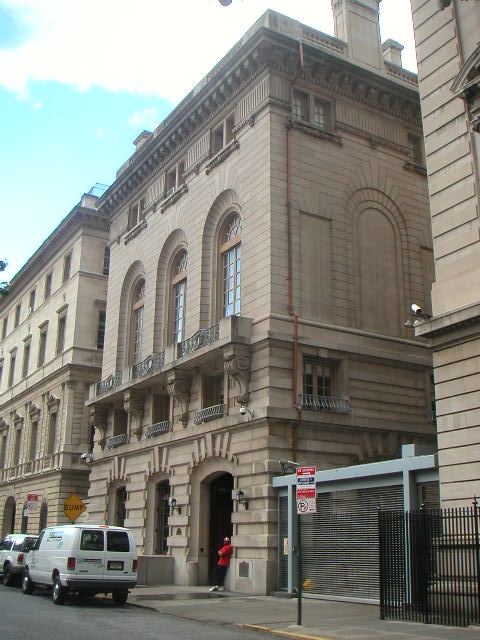 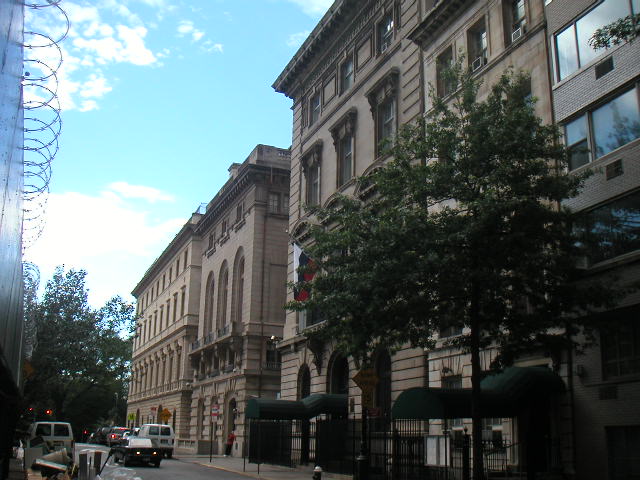 |
|
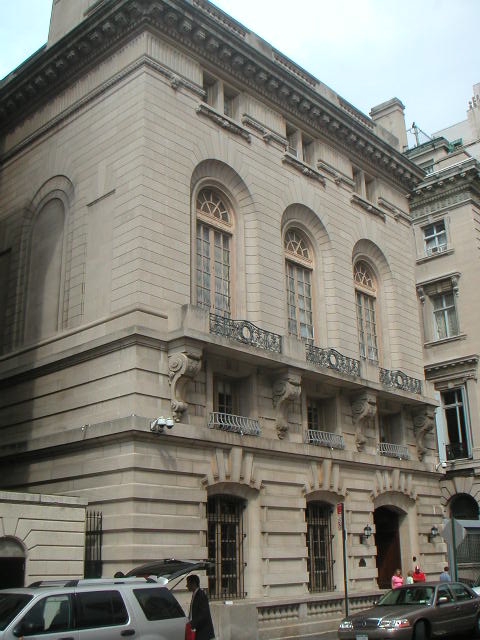 |
|
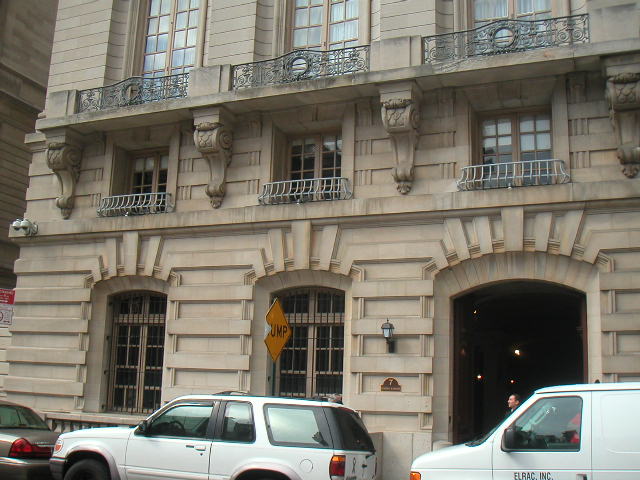 |
|
|
images |
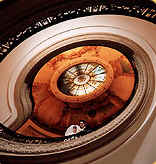 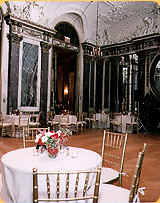 |
|
|
|
|
Hailed by the Landmarks Preservation
Commission as “the finest Beaux Art townhouse rooms in the City,” the
James Burden Mansion stands majestically at 7 East 91st Street, off
Fifth Avenue. The Burden Mansion has a suite of three distinctly French
rooms available for entertaining. The ballroom can accommodate 150 for a
seated meal and up to 110 for dining and dancing. The adjacent reception
room is also suitable for dancing. The banquet hall can be used for
cocktails, or additional dinner seating for 90. Up to 280 guests in
total can be invited to a cocktail reception at the mansion. Designed in 1902 by distinguished architect Whitney Warren, the Italian Renaissance-style residence was built for steel manufacturer James A. Burden, Jr. and his wife, the former Florence Adele Sloane, a great-granddaughter of Commodore Cornelius Vanderbuilt. It was Mrs. Burden who began the tradition of lavish entertainment on the mansion's third floor. Now, almost a century later, the Burden Mansion continues to be the setting of choice for special occasions. Upon entering the mansion, visitors' first glimpse is of a sweeping spiral staircase of Hautville marble. The staircase, which rises from a handsome rotunda, is crowned by a cupola showing a rich mural by French Artist Hector d'Espouy. The third floor reception rooms, all of which reflect the grandeur of the Belle Epoque, consist of a ballroom, banquet hall, and reception room. The ballroom, echoing the period of Louis XIV and the Hall of Mirrors of Versailles, is resplendent with tapestry, Campan Vert Durance marble walls of white and dark rose and its original herringbone parquet floor. The ornate guilded fireplace and floor-to-ceiling arched windows are complimented by a spectacular white ceiling decorated with cherubs. Simple, elegant mirrored doorways lead guests from the ballroom to the banquet hall, brilliant with marble walls of deep green, accented with gold leaf and marble parquetry floors. The reception room, with walls of soft gray accented with gold leaf, is adorned with a gold-coffered ceiling. A Steinway grand piano is in place for the pleasure of guests. |
|
|
The Battle of Carnegie Hill On the surface, it's a classic showdown between homeowners resistant to change and neighbors intent on improving what is, after all, their own property. But up where Andrew Carnegie built his mansion, the ranks of the preservationist army include Kevin Kline, Paul Newman, and the Patton of the perambulator set, Woody Allen. By Ralph Gardner Jr. Jurate Kazickas, a senior officer in the people's army fighting the development of an apartment building over the Citibank branch at the corner of 91st Street and Madison Avenue, was walking down the street last spring when she spotted Citigroup CEO Sanford Weill, whose company had sold the right to develop the property, leaving the restaurant Vico with his wife, Joan. "Before he could get into his car, I went up to him and said, 'You've got to do something. Please, please, can we have a meeting with you?' " recalls Kazickas, a journalist and the wife of former deputy Treasury secretary Roger C. Altman. "I basically said, 'You have no idea how upset we are,' and I launched into this tirade and said, 'Buy it back. Please buy it back.' He said, 'Why don't you buy it back?' " The billionaire eventually told his assailant, whom he knew socially, to call his office. "We were able to get a meeting with the general counsel of Citibank and the public-affairs person," Kazickas continues. "And they were very upset that the neighborhood was upset. It was one of those things that slipped through the cracks. I really honestly think they had no clue the developer was going to do this horrendous thing the community would go wild about." All politics may be local. But in Carnegie Hill it's zeroed in to the level of lintels, cornices, and flower beds, as preservationists and ladies who lunch square off against developers, schools that want to grow, and even one another in an effort to keep the neighborhood safe for nannies pushing McClaren strollers and movie crews seeking authentic nineteenth-century locations for generations to come. The war between those who want to develop Manhattan, and usually succeed, and those who want to keep it the way it is is nothing new. What makes Carnegie Hill different is that the combatants in one of the city's hottest neighborhoods are more evenly matched. This is less David versus Goliath than Ali versus Frazier, both sides trotting down to the Landmarks Preservation Commission on an almost weekly basis, it seems, with their lawyers and tweedy architects in tow. The opposing camps come out for the final showdown on April 3, when the anti-tower activists hope to persuade Landmarks to make the developer scale back his already scaled-back proposal even further. "I love the Spence School," says Carnegie Hill resident Woody Allen. "But you can't buy a landmark house and go about changing it." If anything, the preservationists appear to have the upper hand, armed as they are not only with righteous indignation, social contacts, and the discretionary income to bankroll their favorite causes but also with their own human missile-defense shield in the unassuming form of Woody Allen. Allen and his wife, Soon-Yi, moved into a 92nd Street mansion a couple of years ago, and Allen, in whose films Manhattan strides the screen like a lovable colossus, almost instantly became the neighborhood's preservation poster boy. "When I got up to Carnegie Hill, they asked my help almost immediately, and it never stopped," Allen explains, though he's not complaining. The director has thus far lobbied the landmarks commission against not only the "Citibank tower," as it's been dubbed by its foes, but also the Spence School's plan to enlarge a landmark mansion on 93rd Street and a neighbor who wants to expand the back of his brownstone. Woody Allen's efforts have even included the making of a short, charming homage to Carnegie Hill that features a soundtrack, trademark Allen voice-over, and special effects. The video, which went into extremely limited distribution -- it was screened a couple of times at fund-raisers for CitiNeighbors, the grass-roots organization fighting the Citibank building, and sent to every member of the landmarks commission -- culminates with a Darth Vader-ish shadow meant to suggest the proposed tower's height, ascending unsociably toward the heavens. "It isn't a small issue of rich against rich," Allen asserts. "It's people who care about the city versus people who don't care enough about it. "Carnegie Hill is one of the two or three sections of the city," he adds, "that represent New York City at its most historically charming." Perhaps unsurprisingly, one property owner insists his stalled project would already be nearing completion were it not for his neighborhood's high-profile residents. "The landmarks people are starstruck," this person complains. Not that many years ago, Carnegie Hill, which acquired its name when Andrew Carnegie built a mansion there in 1901 (today the Cooper-Hewitt museum), was considered something of a backwater, a place for those who couldn't afford the prices south of 86th Street but remained wedded to the concept of the Upper East Side's Gold Coast. In fact, part of its current sex appeal, according to Lo van der Valk, the president of Carnegie Hill Neighbors, a preservation group, is the felicitous result of what he describes as the "Rip Van Winkle" effect. "We were passed over by major conversions and demolition and rebuilding," he explains. "And by the time Rip Van Winkle woke up, the landmark laws were in full sway." But the sleep had definitely been rubbed from old Rip's eyes by the mid- to late nineties as well-to-do baby-boomers, flush with their Wall Street winnings and attracted by the neighborhood's private schools and human scale, started to bid up the prices for townhouses. Homes that sold for under $1 million a decade ago now routinely sell in the $3 million-to-$4 million range. A strong economy also helped the schools, making it easier to persuade wealthy parents to open their wallets, and to upgrade their facilities. And developers, eyeing the neighborhood's cozy restaurants, tony toy shops, and chic children's-clothing boutiques, saw in Carnegie Hill a neighborhood begging for the convenience of condominium living. "The irony is, the wealth of the first Gilded Age that built the community is being deconstructed by the wealth of the second Gilded Age," claims Van der Valk. While it's easy to tar the developers as evil, the case against schools such as Spence and the Convent of the Sacred Heart (which also finds itself in the preservationists' crosshairs) is harder to make. They're the reason many families move to the neighborhood in the first place, and they've also proved themselves rather reliable stewards of their property -- not just in flush times but also when the economy goes into a tailspin and former masters of the universe find themselves relocating to the suburbs or the Sun Belt. In 1999, Spence purchased the landmarked Billy Rose mansion, best known as the Smithers center, a former drug- and alcohol-treatment facility whose celebrity patients included pitcher Dwight Gooden. Spence, whose main building is two blocks away at 22 East 91st Street, planned to extend the roof, build an underground gym, and move its lower school there. One might have thought the community would have welcomed the school's well-scrubbed little girls, but the preservationists balked at the plans. "We're engaged in a process of working cooperatively with the landmarks commission to arrive at a responsible plan to restore and preserve the landmark while also meeting the academic needs of the school," says Arlene Gibson, Spence's head of school. "I love the Spence School," says Allen, whose wife took a brief turn student-teaching there in 1997, "but you can't buy a landmark house and go about changing it." In January, Spence was effectively sent back to the drawing board by the landmarks commission and has since scaled back its proposal, lopping off a proposed sixth floor and making other changes. In another case, Carnegie Hill Neighbors supported a temporary restraining order in State Supreme Court against the city's Board of Standards and Appeals in the hope of overturning the approval the city gave the Convent of the Sacred Heart to enlarge a rear yard addition that connects the Kahn and Burden mansions, at 1 and 7 East 91st Streets, respectively, both of which the school occupies. Preservationists oppose the work on the grounds that it's too high and will reduce the light behind the school. Perhaps the most intimate battle in which Allen found himself engaged involved the plans of a family named Fisch, who live several doors east of him, to expand their brownstone ten feet into their backyard. The Fisches' neighbors, who include gourmet grocer Eli Zabar, claimed that the construction, which requires burrowing seventeen feet underground, would destroy the peace, tranquillity, and natural beauty of the interconnected gardens that the Allens, Zabars, Fisches, and several other families share. "We all got together and offered to buy the house at fair market value," explains Allen. "We felt perhaps they just picked the wrong house for what they want." "He was insulted," says Ross Moskowitz, Michael Fisch's lawyer. "He has lived in Carnegie Hill for twenty-some-odd years. He and his family have been stellar members of the community. They were outraged by the arrogance to assume they would leave the neighborhood." Carnegie Hill Neighbors' Lo van der Valk found himself stuck between the proverbial rock, or rather common rear façade, and a hard place. "I don't like to side with one group of neighbors over another," he explains cautiously, "but this is a unique space." On February 27, the landmarks commission awarded the Fisches a partial victory, granting them a two-story-high rear-yard extension rather than the five-story addition they wanted. But, says a neighborhood activist who considers the internecine warfare on 92nd Street a distraction from Carnegie Hill's serious work, "what worries me is all these neighbors were making a scene in front of Landmarks and squabbling among themselves and queering the pitch for the big carbuncle that's going to go up on the corner." She's referring, of course, to the Citibank "tower." The beauty of that project, so to speak, is that at least everybody agrees on who the enemy is: the Tamarkin Company, whose proposed seventeen-story building, on one of Madison Avenue's last open spaces, allowing in marvelous morning sunlight, has already been whittled down to eleven stories and counting. The movement to thwart the plan started when Carol McFadden, who sold her townhouse to Woody Allen and moved to the hinterlands of the East Eighties but remains active in the preservation of Carnegie Hill, got wind of the proposed tower while chatting with a neighbor. "It was just a whisper on a street corner," she recalls. "We hired a lawyer. We put our hands all the way around the block" (a show of solidarity at a protest meeting last February). "We had a wreath that said R.I.P.," to call attention to the "death" of the historic neighborhood, she continued, "and quiet Sunday that it was, the media took an interest in us." McFadden also scissored her Citibank ATM card for dramatic effect, a move she quietly regrets, since it has forced her to bank at an HSBC ATM at 45 East 89th Street, a huge residential skyscraper built during the seventies that creates a howling wind-tunnel effect, and whose construction Carnegie Hill Neighbors was created to fight. Joining McFadden on the barricades have been Paul Newman and Kevin Kline. On February 8, 2000, CitiNeighbors turned out several hundred strong for the landmarks commission's hearing on the project, an encounter that developer Cary Tamarkin likened to "having my head banged against a wall for five hours continuously." Sony Corporation of America CEO Sir Howard Stringer, another Carnegie Hill resident, was among those who testified against the project, at McFadden's request. "Everybody else was a housewife," she recalls. "He's a person who actually has a salary. He stepped up into this huge void and gave the most eloquent ten-minute talk I ever heard. "Kevin Kline came to the second landmarks meeting and quoted Richard II," the ebullient McFadden continues, referring to an event on May 16 where Kline declaimed, "How sour sweet music is, when time is broke, and no proportion kept!" ("It just slayed them in the aisles," she says.) In June, the landmarks commission unanimously rejected the initial design, and in December, Tamarkin came back with a revised proposal cutting the building from seventeen stories and 214 feet to eleven stories and 142 feet. But that didn't satisfy its opponents. "They have these nice little six-story townhouses," Jurate Kazickas explains, of the Queen Anne row houses just north of Citibank. "We'd like another six-story townhouse." However, the coalition of groups that has opposed the building may be starting to fray. Friends of the Upper East Side Historic Districts, Civitas, and the Municipal Arts Society are apparently going to give the project their blessing, or at least not oppose it, at the landmarks commission's April 3 hearing. "Friends doesn't make comment until we testify at Landmarks," says Lisa Kersavage, the organization's executive director. "But Tamarkin did come to us, and the height is more appropriate than the previous one. We don't want to turn this into an adversarial situation. That's a big reason we're not commenting. "They've had so many projects up there," she continues, referring sympathetically to Carnegie Hill, "I think that neighborhood feels under siege right now. They're reacting very strongly to every proposal." While the momentum may be shifting in the developer's favor, don't count out Carnegie Hill's intrepid band of guerrilla fighters just yet. CitiNeighbors' campaign coffers are perilously depleted, according to one of their leaders, but Woody Allen has agreed to screen his new movie at a $500-a-head fund-raiser for the group this spring. Whatever the resolution, one thing seems almost certain: Some future Allen movie will incorporate the pageantry and pathos of the Landmarks war. "I'm sure it will find its way into my work," he says. "The whole thing is quite interesting if you choose to play it for laughs. Of course, when you're there it's dead serious, because there's a lot at stake." |
|
|
links |
http://www.cshnyc.org/rentals.htm |